Renowned for its therapeutic baths, the Arima spa resort area is one of the oldest and most prominent spas in Japan. First mentioned in Japan's oldest history book "Nihon Shoki," written in 720 A.D., the mineral baths of Arima were popular with Toyotomi Hideyoshi, the feudal ruler who unified Japan in 1590.
He was also called "Taiko" Hideyoshi. This honorific title was given to a resigned Kanpaku, the highest rank of the Emperor's retainers, and often referred to Hideyoshi since he was quite famous for his success in being promoted from the lowest rank of Oda Nobunaga's infantry to the Kanpaku.
Thanks to the efforts of Hideyoshi and his wife Nene, the areas of Arima Onsen recovered from the serious damage incurred by repeated disasters such as big fires in 1528 and 1576, a war in 1545, and a major earthquake in 1596. Today, these hot springs continue to be a favorite holiday destination with Japanese and overseas tourists alike.
![]()
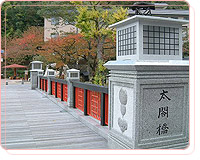
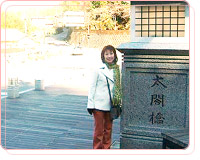
A bridge named after "Taiko" Hideyoshi was built over the Arima River and is located close to the Arima Onsen Station of Kobe Railway. During the summer holiday season many visitors crowd on and around this bridge to enjoy various shows including a geisha dance performed on the riverbanks.
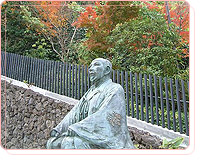
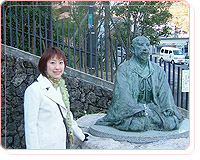
"Yukemuri (Vaporous) Plaza" is located very close to the Taiko-hashi Bridge in the center of the Arima spa resort area. A statue of Hideyoshi is found in front of a big fountain in the Plaza. At night this fountain is lit up to create a dreamy atmosphere.
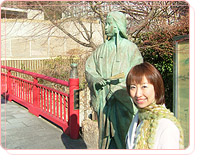
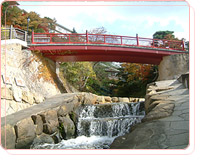
When you walk a small distance upstream along the Arima River from Taiko-hashi Bridge, you'll see a small red bridge named after Hideyoshi's wife, Nene, along with a statue of her. After Hideyoshi's death, she endeavored on behalf of Arima's revitalization.
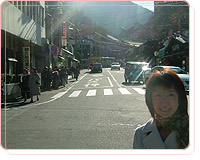

This is a main street of the Arima spa resort area named after Taiko Hideyoshi where many souvenir shops stand creating a nostalgic atmosphere.
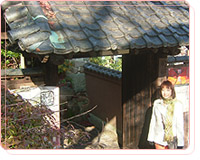
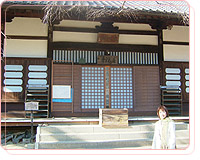
Founded by a high priest Gyoki and later renovated by his successor Ninsai, Zenpukiji Temple receives many visitors wishing to offer prayers to a wooden sculpture of Shotoku Taishi. The wooden statue was created during the Kamakura Period and is registered as an important national treasure. In addition to the sculpture, visitors can view a bit larger teakettle that has an interesting story involving Toyotomi Hideyoshi.

One day Hideyoshi visited a Zen temple near Mt. Tenjin called Amida-do where he saw the large head of the chief priest. Hideyoshi thought that the head of the chief priest resembled a large boar and remarked to the priest. "You have a strange head; let's call for Rikyu." He called for Sen-no-Rikyu, the most famous master of the tea ceremony, and ordered him to have a teakettle made in the shape of the chief priest's head. Rikyu asked the great craftsman Yojiro to make the kettle. Upon its completion, the teakettle was named "bullnecked kettle." However, people called it "Amida-do," and this is how Amida-do teakettle got its start for use in tea ceremony.
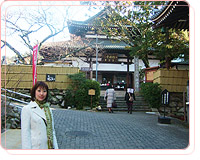

The origin of the name for Negai-zaka involves a visit to Arima by Toyotomi Hideyoshi in 1589. When Hideyoshi climbed to an overlook in a high mountain facing the southwest from Seiryoin, he tapped the ground and declared, "If this area has a hot spring that gushes up from the ground, all of the land to the sea is probably mine." He commanded the ground, "Erupt with hot water!" As he spoke these words, hot water began gushing at their feet little by little, and a hot spring developed. People began calling this hot spring such names as Kami-no-yu or Hot Spring of the Upper and the Negai-no-yu or Hot Spring of Wish. Although the hot spring stopped gushing when Hideyoshi died, the sloping path from Onsenji Temple to Nenbutsuji Temple is still called "Negai-zaka" or Slope of Wish even today.
Nenbutsuji Temple has been called the imprint of the villa from Toyotomi Hideyoshi's wife "Nene" and has a spectacular view of the entire area. The main hall was built in 1712 and is the oldest building in the Arima Onsen area. Its garden, called the Sal Tree Garden, features a sal tree whose age is over 250 years. Each year in late June when summer is just beginning in Japan, the tree displays its beautiful flowers, and there is an appreciation festival held at the temple for the Sal flower and the ichigen-kin, a one-stringed instrument.
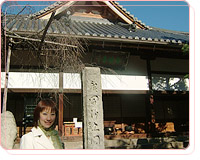
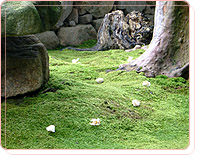
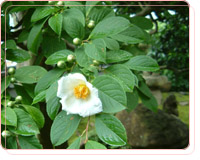
When the Gokurakuji Temple's kitchen was being rebuilt from its collapse during the Kobe Earthquake in 1993, workers discovered ruins dating back more than 400 years before. Upon examination, it became clear that these ruins were the bath and garden of Yunoyama Goten built by Taiko Hideyoshi. To commemorate the site, the city of Kobe opened a museum in April 1999 exhibiting the mushiburo (steam bath) and iwaburo (bath in stone) and preserved these baths in their original condition along with tea ceremony items and Japanese tile discovered at the ruins indicating the relationship of Hideyoshi and Arima Onsen.
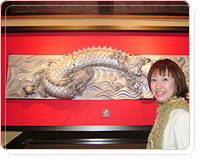
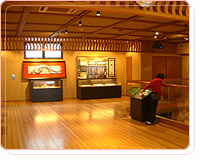
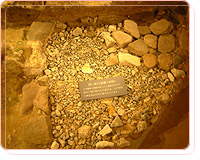
Referring to tranquility of this beautiful Japanese garden of the former Zuihoji Temple, Toyotomi Hideyoshi once said of the garden, "No matter how much you see of it, you never grow tired of it." With places for resting scattered all throughout, the Zuihoji Park is meant to enjoy slowly. In autumn, visitors can enjoy the beautiful leaves with their autumn hues while having a bowl of udon noodles, warm oden, or sweet Japanese sake. The park has also been chosen by Kobe City as one of its 50 designated places to see beautiful cherry blossoms.
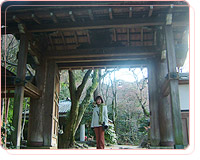
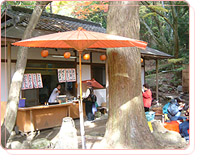
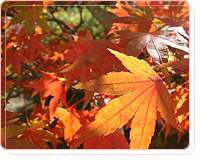
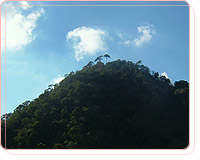
A 619-meter high small hill is located 1km south from the Arima town area. When Sen-no-Rikyu, a master of the tea ceremony, once hosted a prominent tea ceremony in Arima by order of Hideyoshi, he piled up ash modeled after this hill's shape on his hearth. That's why the hill was later named Haigata-yama or Ash-shaped Mountain.










